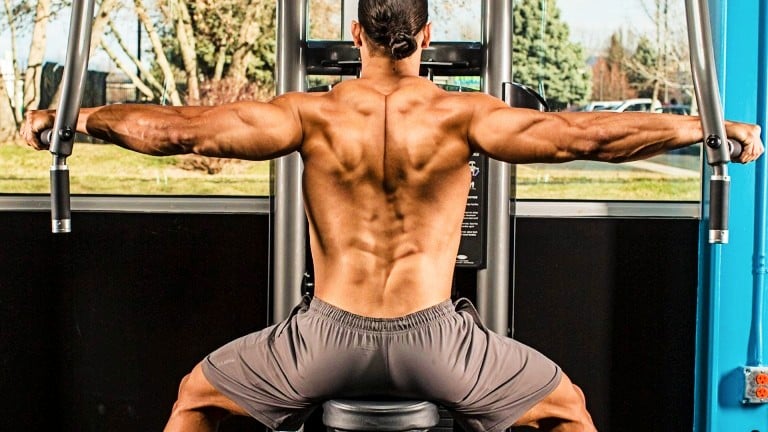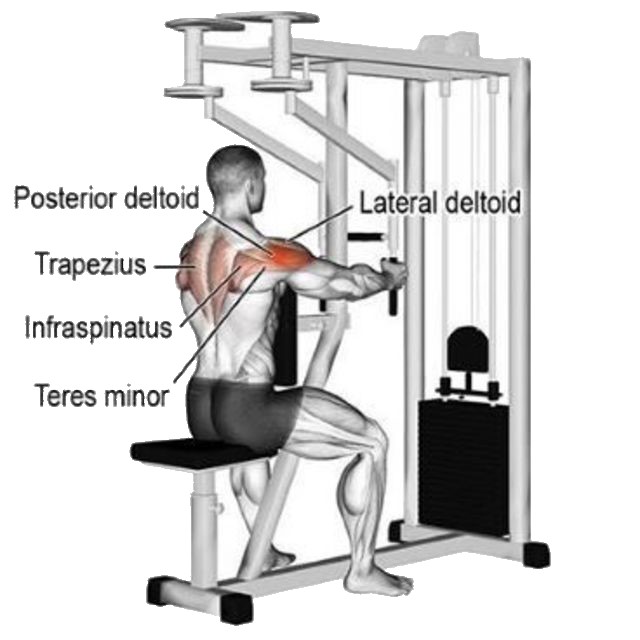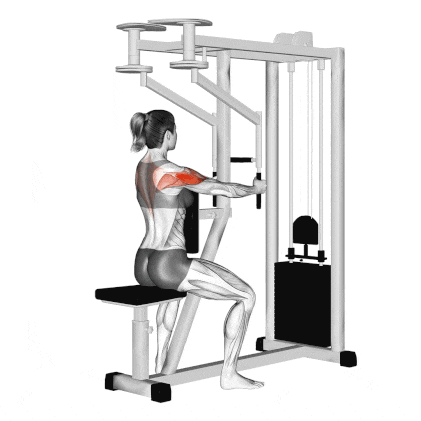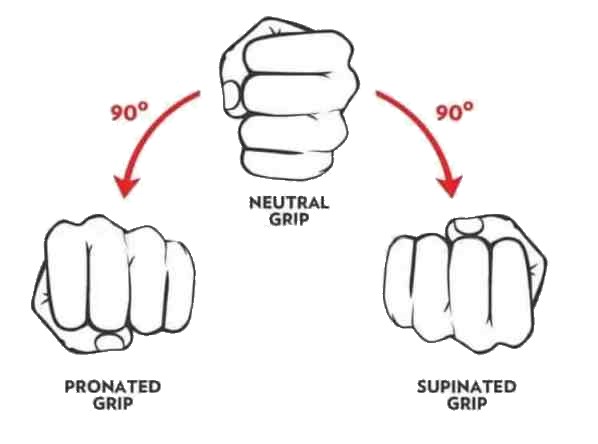The pec deck rear delt fly, also known as the rear delt machine fly or reverse pec deck fly, is a simple yet effective exercise that increases deltoid muscle definition and strength.
The pec deck rear delt machine fly is an isolation exercise that targets your upper back muscles and shoulder muscles, particularly the rear deltoids, (backside of your shoulders), Traps and rhomboid.
However, the term ‘isolation movement’ can be misleading. To avoid confusion, it is more accurately described as a single-joint exercise.
Imagine spreading your arms wide as if you were giving someone a big hug, but in reverse, instead of pulling forward like a machine chest fly.
It offers several advantages over other rear delt fly.
- The machine’s setup and adjustability are user-friendly, allowing for a hassle-free workout experience.
- Minimizes the involvement of other muscle groups.
- The machine provides consistent resistance throughout the movement.
- Improve posture by reducing the effects of rounded shoulders.

- Reverse Pec Deck Fly Muscle Worked
- How To Do Pec Deck Rear Delt Machine Fly
- Tips And Form
- Different Grip Position Of Pec Deck Machine Rear Delt Fly
- Pronated Grip (Overhand Grip)
- Hammer Grip (Neutral Grip)
- Supinated Grip (Underhand Grip)
- Variations Of Pec Deck Rear Delt Fly
- 1. Single-Arm Pec Deck Rear Delt Fly
- 2. Alternating Reverse Peck Deck Fly
- Best Alternatives Of Pec Deck Rear Delt Fly
- Rear Delt Machine Fly vs. Rear Delt Dumbbell Fly
- Rear Delt Fly Machine:
- Dumbbell Rear Delt Fly
- FAQs
- Is the rear delt fly machine effective?
- Is the reverse pec deck for the back or shoulders?
- Conclusion
- References
Reverse Pec Deck Fly Muscle Worked
- The rear delt machine flys primarily muscle worked Rear deltoid.
- The pec deck delt fly involves several other secondary and stabilizing muscles, including the Rhomboids, Infraspinatus, teres minor, teres major, Lateral Deltoid, Trapezius, and Forearm Extensors.

Want to take your gains to the next level? Discover your daily calorie needs with our free TDEE calculator
How To Do Pec Deck Rear Delt Machine Fly
- Adjust the seat height and position of the handles so your shoulders line up with the machine’s pivot point.
- Sit on the machine with your chest against the pad or support. Your feet should be flat on the floor, and your knees should be slightly bent.
- Hold the handles with a neutral grip (palms facing each other). Your arms should be almost straight out, parallel to the floor.
- Maintain a tall, upright posture and keep your shoulders relaxed.
- Maintaining a slight bend in your elbows and pull your arms outward and backward in an arc-like motion.
- Continue to pull until your arms are stretched out to the sides.
- Hold the contracted position briefly to emphasize the tension in your rear deltoids.
- Slowly release the tension and return your arms to their starting position.
Tips And Form
- Start with lighter weights to focus on technique and form.
- Keep a slight bend in your elbows to reduce elbow and shoulder joint stress.
- Actively pull your shoulder blades together (scapular retraction) throughout the movement.
- Ensure the handles move in a plane parallel to the floor and in line with your shoulders.
- Focus on squeezing your shoulder blades together at the peak of the movement to activate your rear deltoid muscles.
- Keep your wrists neutral (in line with your forearms) to reduce unnecessary strain and maximize force transfer to your rear delts.
- Don’t overextend at the end of the movement. Stop when your arms are roughly in line with your torso. Going too far back can compress the shoulder joint.
- Perform the exercise slowly and calmly, emphasizing the eccentric (lowering) phase.
- Exhale as you pull your arms back, and inhale as you come back. Keep your breathing steady throughout the exercise.
- Select the reps and sets according to your fitness level. As you become more comfortable with the form, change your set and rep ranges to challenge yourself.
| Level | Reps | Sets | Frequency |
|---|---|---|---|
| Beginners | Start with 8-10 | 2-3 | 1-2 times per week |
| Intermediate | Aim for 10-15 | 3-4 | 2-3 times per week |
| Advanced | 12-15+ | 4-5 | 2-3 times per week |
Different Grip Position Of Pec Deck Machine Rear Delt Fly
Different grip positions can provide other benefits and target the rear deltoid muscles from slightly different angles. The study shows that during machine rear delt fly the rear delt and infraspinatus activation is significantly more significant with a neutral grip.
Pronated Grip (Overhand Grip)
In this grip position, your palms are facing downward.
- The pronating grip emphasizes the posterior deltoids and helps engage the rear delts outer portions.
- The pronating grip encourages greater shoulder external rotation, improving mobility and flexibility in the shoulder joint.

Hammer Grip (Neutral Grip)
The hammer grip refers to a grip position where your palms are facing each other, similar to holding a hammer.
- The neutral grip distributes the workload more evenly between the rear deltoids and the middle delts.
- When you hold the handle with a neutral grip, you reduce wrist and joint strain compared to other grip positions.

Supinated Grip (Underhand Grip)
In a supinated grip, your palms are facing upward.
- It places greater emphasis on the rear deltoids, helping to isolate and target them more effectively.
- The supinated grip also recruits the biceps to a greater extent.

Know More: 25 Best Rear Delt Exercises For Mass And Strength
Variations Of Pec Deck Rear Delt Fly
1. Single-Arm Pec Deck Rear Delt Fly
Instead of using both arms simultaneously, perform the exercise one arm at a time.
This variation helps to address any strength imbalances between the two sides and improves focus and isolation of the rear deltoid muscles.
2. Alternating Reverse Peck Deck Fly
The Alternating machine rear delt fly is an exercise variation in which you perform the movement with one arm at a time in an alternating fashion.
You should sit on the machine, grab the handles with an overhand grip, retract your shoulder blade, and pull your one arm outward and backward.
Best Alternatives Of Pec Deck Rear Delt Fly
You can try these alternatives if you want a similar exercise to replace the pec deck machine rear delt fly during your training sessions.
- Renegade Row
- Band Pull Apart
- Cross Over Rear Fly
- Landmine Row
- Upright Row
- Face pull
- T Bar Row
- Rear Delt Row
- Bent Over Reverse Fly
Rear Delt Machine Fly vs. Rear Delt Dumbbell Fly
Rear Delt Fly Machine:
- The machine provides focused isolation and engagement for the rear deltoid muscles.
- It provides consistent resistance throughout the movement.
- The pec deck machine provides stability and support, which reduces the risk of improper form or injury.
- Machines are generally easy to use, making them suitable for beginners or those who struggle with coordination or balance during free-weight exercises.
Dumbbell Rear Delt Fly
- The dumbbell rear fly allows for a wider range of motion and provides a deeper stretch and contraction of the rear deltoids.
- It requires more stabilizing muscles, which leads to increased muscle activation and development.
- Using dumbbells is hard because you must maintain the correct posture while doing this exercise.
- Dumbbells are easy to find and can be used at home or in the gym. This means you can do dumbbell rear-fly exercises whenever you want.
FAQs
Is the rear delt fly machine effective?
Yes, the rear delt fly machine can be an effective exercise for targeting and strengthening the rear deltoid muscles. It provides a consistent resistance throughout the range of motion, and offers various grip adjustment options.
How much weight should I lift on the rear del pec deck fly?
You should always choose your weight based on your experience, no matter your exercise. Lifting too heavy can worsen your form and increase your risk of injury.
Is the reverse pec deck for the back or shoulders?
The reverse pec deck is beneficial for both your back and shoulders. It targets the upper back and shoulder muscles, specifically the traps, deltoid, and rhomboids.
Conclusion
Don’t overlook the significance of working out your rear deltoids as part of your workout regimen.
The pec deck machine rear delt fly is an excellent exercise for anyone who wants to shape their shoulders and improve their posture and mobility.
You will notice improvements in shoulder strength when you consistently challenge and engage your rear deltoids.
References
- Campos YAC, Vianna JM, Guimarães MP, Oliveira JLD, Hernández-Mosqueira C, da Silva SF, Marchetti PH. Different Shoulder Exercises Affect the Activation of Deltoid Portions in Resistance-Trained Individuals. J Hum Kinet. 2020 Oct 31;75:5-14. doi: 10.2478/hukin-2020-0033. PMID: 33312291; PMCID: PMC7706677.
- Schoenfeld B, Sonmez RG, Kolber MJ, Contreras B, Harris R, Ozen S. Effect of hand position on EMG activity of the posterior shoulder musculature during a horizontal abduction exercise. J Strength Cond Res. 2013 Oct;27(10):2644-9. doi: 10.1519/JSC.0b013e318281e1e9. PMID: 23302754.

Manish is a NASM-certified fitness and nutrition coach with over 10 years of experience in weight lifting and fat loss fitness coaching. He specializes in gym-based training and has a lot of knowledge about exercise, lifting technique, biomechanics, and more.
Through “Fit Life Regime,” he generously shares the insights he’s gained over a decade in the field. His goal is to equip others with the knowledge to start their own fitness journey.
